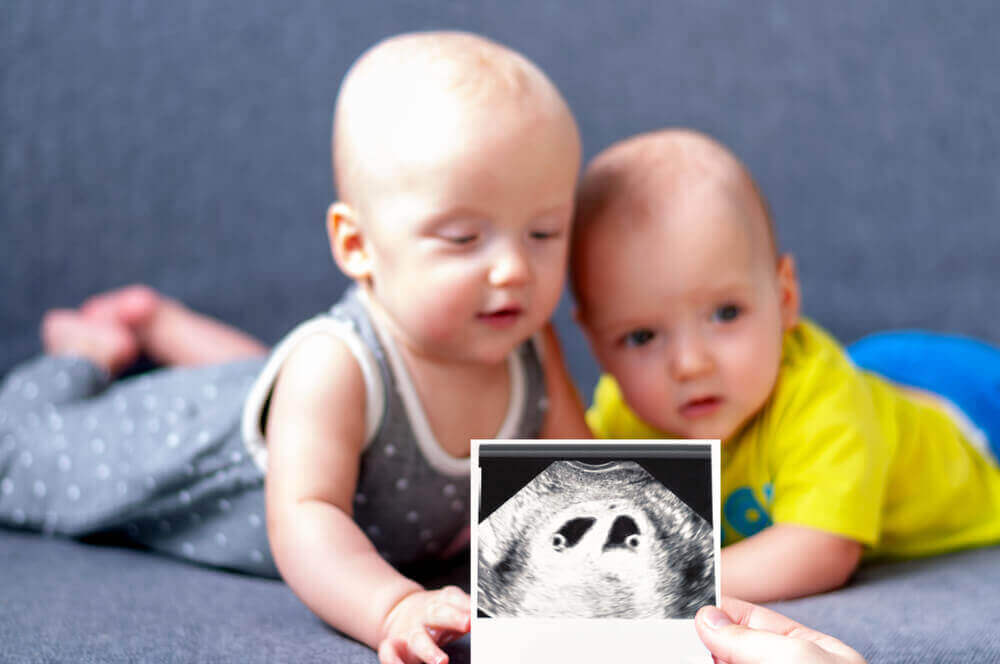Do You Know the Difference between Identical and Fraternal Twins?

Many people want to have twins, mainly because they want to see their children grow up together while sharing wonderful moments as siblings. However, have you ever wondered what the difference is between identical and fraternal twins?
Although it may not seem so, the differences are key points to understanding and caring for them properly. For this reason, we invite you to continue reading if you want to know more about these distinctions.
Why it’s Important to Know the Difference between Identical and Fraternal Twins

It’s important to know the difference between identical and fraternal twins because the pregnancies should be treated differently in each case. Although most of these pregnancies are fairly typical, there’s a possibility that some complications might occur. For example, fetal fetus transfusion or intrauterine growth retardation are possible.
For this reason, in order to adequately manage a pregnancy with twins, it’s essential that know which type of pregnancy you have as soon as possible. In fact, according to the book Clinical Obstetrics by Drs. E. Albert Reece and John C. Hobbins, an ultrasound in the first trimester can identify whether your twins are identical or fraternal. Likewise, any possible fetal anomalies or other type of complication can be detected in time.
In order to identify what type of pregnancy you have, there are some factors that you should consider. They’re easy to understand, and will help you determine if you have identical or fraternal twins.
Different fertilization
Dizygotic twins, that is, fraternal twins, are those produced by the fertilization of two eggs and two sperm. At the time of fertilization, the ovaries release two eggs. Since men have millions of sperm, it’s normal for both to become fertilized.
In a pregnancy with fraternal twins, each fetus has its own amniotic sac and placenta. Therefore, they may or may not have the same sex, and their resemblance will be like that of two siblings born in different births.
On the other hand, monozygotic twins, that is, identical twins, are produced when a single egg is fertilized with a sperm. This forms a zygote, which then divides into two, developing two fetuses.
If the division occurs between the first and fourth day of fertilization, each fetus will have its own placenta and amniotic sac. On the other hand, if it happens between the fourth and the eighth day, each fetus will have its own sac, but they will share the same placenta.
With identical twins, what happens is a “natural cloning.” Although each one develops independently, they are formed by the same egg and sperm. Therefore, they share the same genetic load and are physically almost identical.
Fraternal twins can be opposite sexes
It’s common that out of every 100 pregnancies of fraternal twins, 50 will be of different sexes. Likewise, the following study from the Institute of Psychiatry in the United Kingdom explains that the sex of twins is a factor that influences their development.
- Once they are born, boys often develop their physical abilities better. That is, they learn to crawl first and then to run and jump.
- In contrast, girls are more communicative. Before they start crawling or walking, they say their first words.
Identical Twins are Very Similar in Appearance

Monozygotic twins share the same hereditary material since both were born from the same fertilized egg that was divided in two after conception. Any difference that exists between them once they are born will be caused by external factors, like food and exercise.
Twins interact inside the uterus; that is, they instinctively seek each other out. Being inside the mother’s womb, they usually look for and touch the other more than themselves. From the time they’re inside their mother, they create an unbreakable bond.
In general, they develop as if they were facing one another. That is, one is the reflection of the other. So, if one is right-handed, the other will be left-handed. If one has a spot on the right arm, the other will have it exactly in the same place, but in the left arm.
Although they look alike physically, there are some features that aren’t identical. The following study published in the Journal of Forensic Identification show that the fingerprints of identical twins are different. When identical twins are forming, each one touches the amniotic sac in different places, which generates different lines on their fingers. As a result, they don’t have the same fingerprints.
Read this article: The Genetic Origin of Sex: the X and Y Sex Chromosomes
Fraternal Twins Share Only 50% of Their DNA

Genetically speaking, all living beings have two copies of each gene. This includes one that’s inherited from the mother and one that’s inherited from the father. That is, half of the genes come from the egg and the other from the sperm.
According to an article by a researcher at the University of the Republic, fraternal twins (coming from different eggs and sperm) only share 50% of their DNA and may even have different blood types. Therefore, they’re siblings born in the same birth without any other similarity.
Conclusion
Popular beliefs claim that the ability to have twins is hereditary. That is, if in the family there were cases of twins, some people believe that this skips two or three generations.
On the other hand, a 2006 study by Dr. Gary Steinman showed that consuming more milk products increases the chances of conceiving twins. This was determined after comparing the numbers of twins born to vegan mothers and mothers with normal diets.
Have you ever wondered what the differences are between twins and twins? We hope this information’s been useful to you; since the conception of two babies in the womb, at the beginning, can generate some confusion. Therefore, don’t hesitate to consult your gynecologist to clarify any doubts you may have.
All cited sources were thoroughly reviewed by our team to ensure their quality, reliability, currency, and validity. The bibliography of this article was considered reliable and of academic or scientific accuracy.
-
Gary Steinman. Mecanismos de hermanamiento: VII. Efecto de la dieta y la herencia en la tasa de hermanamiento humano. J Reprod Med. 2006 mayo; 51 (5): 405-410. https://www.ncbi.nlm.nih.gov/pubmed/16779988
- E. Albert Reece, John C. Hobbins. Obstetricia clinica / Clinical Obstetrics. Ed. Médica Panamericana, 2010.
- Galsworthy, MJ, Dionne, G., Dale, PS y Plomin, R. (2000). Diferencias de sexo en el desarrollo cognitivo verbal y no verbal temprano. Ciencia del desarrollo, 3 (2), 206–215. https://doi.org/10.1111/1467-7687.00114
- Srihari, Sargur & Srinivasan, Harish & Fang, Gang. (2008). Discriminability of fingerprints of twins. Journal of Forensic Identification. 58. 2008. 109.https://www.researchgate.net/publication/228866108_Discriminability_of_fingerprints_of_twins
- María Sol Leira Permuy (2011). Manual de bases biológicas del comportamiento humano. Comisión Sectorial de Enseñanza (CSE) de la Universidad de la República.
This text is provided for informational purposes only and does not replace consultation with a professional. If in doubt, consult your specialist.








